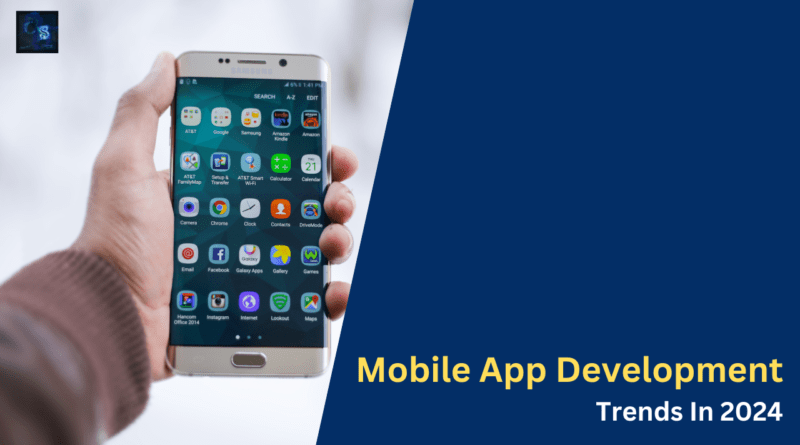Mobile App Development Trends In 2024
Hello, guys, welcome to our blog. Here in this article, we will discuss “Mobile App Development Trends in 2024, Stages of Mobile App Development and changes in usage of Mobile App Development”.
Ask questions if you have any electrical, electronics, or computer science doubts. You can also catch me on Instagram – CS Electrical & Electronics.
Also, read:
- Top 10 High-Paying Electrical And Electronics Jobs In 2023, 2024
- Top 200+ MATLAB Simulink Interview Questions With Answers
- 100 (AI) Artificial Intelligence Applications In The Automotive Industry
Mobile App Development Trends in 2024
Mobile app development is a dynamic field, constantly evolving to meet the changing needs of users and leverage advancements in technology. In 2024, several trends are shaping the landscape of mobile app development, influencing the way applications are designed, developed, and experienced. This essay explores the key trends defining mobile app development in 2024.
01. 5G Integration:
The widespread rollout of 5G networks is transforming mobile experiences, offering significantly faster data speeds and lower latency.
Impact: Mobile apps will leverage 5G capabilities to deliver richer content, enhanced real-time communication, and seamless streaming, unlocking new possibilities for innovation.
02. Augmented Reality (AR) and Virtual Reality (VR):
AR and VR technologies are gaining traction in mobile app development, offering immersive and interactive user experiences.
Impact: Apps incorporating AR and VR will provide users with enhanced gaming, educational, and shopping experiences, blurring the lines between the digital and physical worlds.
03. AI and Machine Learning Integration:
Artificial Intelligence (AI) and Machine Learning (ML) are becoming integral to mobile app functionality, enabling personalized experiences, predictive analytics, and automation.
Impact: AI-driven apps will offer smarter recommendations, personalized content, and improved user engagement, adapting to individual preferences and behaviors.
04. Foldable Devices Optimization:
The rise of foldable smartphones and tablets has prompted developers to optimize apps for various screen sizes and form factors.
Impact: Apps will need to adapt seamlessly to different foldable device configurations, providing a consistent and user-friendly experience across diverse hardware.
05. Internet of Things (IoT) Integration:
The IoT ecosystem is expanding, and mobile apps are increasingly acting as interfaces for connected devices.
Impact: Mobile apps will play a central role in controlling and monitoring IoT devices, creating a unified experience for users managing smart homes, wearables, and other IoT-enabled solutions.
06. Blockchain-Based Apps:
Blockchain technology is finding applications in mobile app development, particularly in enhancing security, transparency, and decentralization.
Impact: Blockchain-based apps will provide secure transactions, decentralized identity management, and traceability, particularly in finance, healthcare, and supply chain industries.
07. Low-Code/No-Code Development:
The adoption of low-code and no-code platforms is rising, enabling rapid app development with minimal coding requirements.
Impact: Non-technical users will contribute to app development, accelerating the delivery of applications and democratizing the creation process.
08. Progressive Web Apps (PWAs):
PWAs combine the best of web and mobile app experiences, offering offline capabilities, fast loading times, and a responsive design.
Impact: As a cost-effective and user-friendly alternative to native apps, PWAs will gain popularity, especially in regions with limited network connectivity.
09. Voice and Conversational Interfaces:
Voice-controlled and conversational interfaces are becoming mainstream, driven by advancements in natural language processing.
Impact: Apps integrating voice interactions will provide users with hands-free and intuitive experiences, transforming the way they engage with applications.
10. Enhanced App Security Measures:
With the increasing frequency of cyber threats, mobile app developers are prioritizing robust security features, including biometric authentication, encryption, and secure APIs.
Impact: Security-conscious users will benefit from safer mobile experiences, fostering trust and confidence in app usage.
The mobile app development landscape in 2024 is characterized by a convergence of technologies aimed at delivering more immersive, secure, and user-centric experiences. Staying abreast of these trends is crucial for developers and businesses looking to create cutting-edge apps that resonate with the ever-evolving preferences and expectations of mobile users.
Stages Of Mobile App Development Trends
Mobile app development is a dynamic process marked by various stages, each influenced by emerging trends and technologies. This essay explores the key stages of mobile app development and the trends shaping each phase, providing insights into the evolutionary journey from ideation to deployment.
01. Ideation and Planning:
The ideation stage involves conceptualizing the app, identifying target audiences, defining features, and creating a roadmap for development.
Trends:
- Market Research and Analysis: Utilizing advanced analytics and market research tools to gather insights into user preferences and competitor landscapes.
- Design Thinking: Applying design thinking principles to empathize with users, ideate innovative solutions, and prototype user-centric features.
02. Design and Prototyping:
In the design phase, UX/UI elements are crafted, and wireframes or prototypes are created to visualize the app’s look and feel.
Trends:
- User-Centric Design: Focusing on user experiences and preferences to create intuitive and visually appealing interfaces.
- AR/VR Integration: Exploring augmented and virtual reality elements in the design for immersive user interactions.
03. Development:
Developers bring the app to life, writing code, integrating features, and ensuring functionality across different devices and platforms.
Trends:
- Cross-Platform Development: Utilizing frameworks like React Native or Flutter for efficient development across iOS and Android.
- Microservices Architecture: Implementing microservices for scalability, flexibility, and easier maintenance.
04. Testing and Quality Assurance:
Rigorous testing is conducted to identify and rectify bugs, ensure functionality, and optimize performance.
Trends:
- Automated Testing: Implementing automated testing tools for faster and more efficient bug detection.
- Security Testing: Prioritizing robust security measures, including penetration testing and code reviews.
05. Deployment and Launch:
The app is released to the app stores, making it available for download by users.
Trends:
- App Store Optimization (ASO): Employing ASO strategies to enhance app visibility, downloads, and user ratings.
- Progressive Web Apps (PWAs): Exploring the deployment of PWAs as a cost-effective alternative to native apps.
06. Post-Launch and Maintenance:
After launch, developers monitor user feedback, address issues, and implement updates to enhance app performance.
- Trends:
- Continuous Integration/Continuous Deployment (CI/CD): Implementing CI/CD pipelines for seamless and automated updates.
- User Feedback Integration: Leveraging user feedback and analytics to prioritize feature enhancements and bug fixes.
07. Evolution and Feature Updates:
The app undergoes continuous improvement with regular feature updates and version releases.
Trends:
- AI-Driven Features: Integrating artificial intelligence for personalized recommendations, predictive analytics, and enhanced user experiences.
- Voice and Conversational Interfaces: Incorporating voice-activated features and chatbots for intuitive user interactions.
08. Adoption of Emerging Technologies:
Developers stay abreast of emerging technologies and trends to ensure the app remains competitive and aligns with the latest user expectations.
- Trends:
- 5G Integration: Leveraging the capabilities of 5G networks for faster data speeds and lower latency.
- Blockchain Integration: Exploring the integration of blockchain for enhanced security and transparent transactions.
In conclusion, the stages of mobile app development are intertwined with evolving trends and technologies, reflecting an iterative and adaptive process. Navigating through these stages requires a keen awareness of industry shifts, user expectations, and the ever-expanding possibilities offered by innovative solutions.
Usage changes in Mobile App Development
Mobile app development has witnessed significant usage changes over the years, driven by advancements in technology and shifts in user behavior. This essay explores the transformative trends that have influenced how mobile apps are developed, highlighting the key usage changes that developers and businesses need to adapt to.
01. User-Centric Development:
Traditional Approach: Historically, apps were often developed based on assumptions rather than user insights.
Usage Change: The paradigm shift towards user-centric development involves prioritizing user feedback, conducting thorough research, and employing design thinking principles.
02. Cross-Platform Compatibility:
Traditional Approach: Native app development for each platform (iOS, Android) was common, requiring separate codebases.
Usage Change: Cross-platform development frameworks like React Native and Flutter enable developers to write code once and deploy it across multiple platforms, reducing development time and costs.
03. Focus on User Experience (UX):
Traditional Approach: Basic functionalities were prioritized over sophisticated user interfaces.
Usage Change: Modern apps prioritize seamless and intuitive user experiences, incorporating attractive designs, smooth navigation, and interactive elements.
04. Microservices Architecture:
Traditional Approach: Monolithic architectures were prevalent, where the entire app was built as a single, tightly integrated unit.
Usage Change: Microservices architecture allows breaking down the app into independent services, facilitating scalability, flexibility, and ease of maintenance.
05. Shift to Agile Development:
Traditional Approach: Waterfall development methodologies with lengthy development cycles.
Usage Change: Agile methodologies, emphasizing iterative development, continuous feedback, and collaboration, enable faster releases and adaptability to changing requirements.
06. Emphasis on App Security:
Traditional Approach: Security measures were often an afterthought, leading to vulnerabilities.
Usage Change: Security is now a primary concern, with encryption, secure APIs, and robust authentication mechanisms integrated into app development processes.
07. Integration of Emerging Technologies:
Traditional Approach: Limited use of cutting-edge technologies like AI, AR, and VR.
Usage Change: Modern apps leverage emerging technologies for enhanced features, such as AI-driven recommendations, AR-based experiences, and VR simulations.
08. User Personalization:
Traditional Approach: One-size-fits-all approaches with minimal personalization.
Usage Change: Apps now strive for personalized user experiences, utilizing data analytics and AI algorithms to tailor content, recommendations, and interactions based on individual preferences.
09. Continuous Integration/Continuous Deployment (CI/CD):
Traditional Approach: Manual deployment processes lead to delays and potential errors.
Usage Change: CI/CD pipelines automate testing, deployment, and updates, ensuring faster and more reliable app delivery.
10. Rise of Low-Code/No-Code Platforms:
Traditional Approach: Coding expertise was essential for app development.
Usage Change: Low-code/no-code platforms empower non-developers to contribute to app development, accelerating the creation of prototypes and simple applications.
11. Remote Collaboration Tools:
Traditional Approach: In-person collaboration was the norm, limiting flexibility.
Usage Change: Remote collaboration tools and communication platforms enable geographically dispersed teams to work seamlessly, fostering global collaboration.
The usage changes in mobile app development reflect a continuous evolution driven by a commitment to user-centricity, technological advancements, and efficient development practices. Adapting to these changes is crucial for developers and businesses aiming to stay competitive and deliver apps that meet the expectations of today’s dynamic user base.
This was about “Mobile App Development Trends in 2024 “. I hope this article may help you all a lot. Thank you for reading.
Also, read:
- 10 Tips To Maintain Battery For Long Life, Battery Maintainance
- Top 200+ MATLAB Simulink Interview Questions With Answers
- 100 (AI) Artificial Intelligence Applications In The Automotive Industry
- 10 Tips To Save Electricity Bills, Save Money By Saving Electricity
- 100 (AI) Artificial Intelligence Applications In The Automotive Industry
- 100 + Electrical Engineering Projects For Students, Engineers
- 100+ C Programming Projects With Source Code, Coding Projects Ideas
Author Profile
- Content Writer








